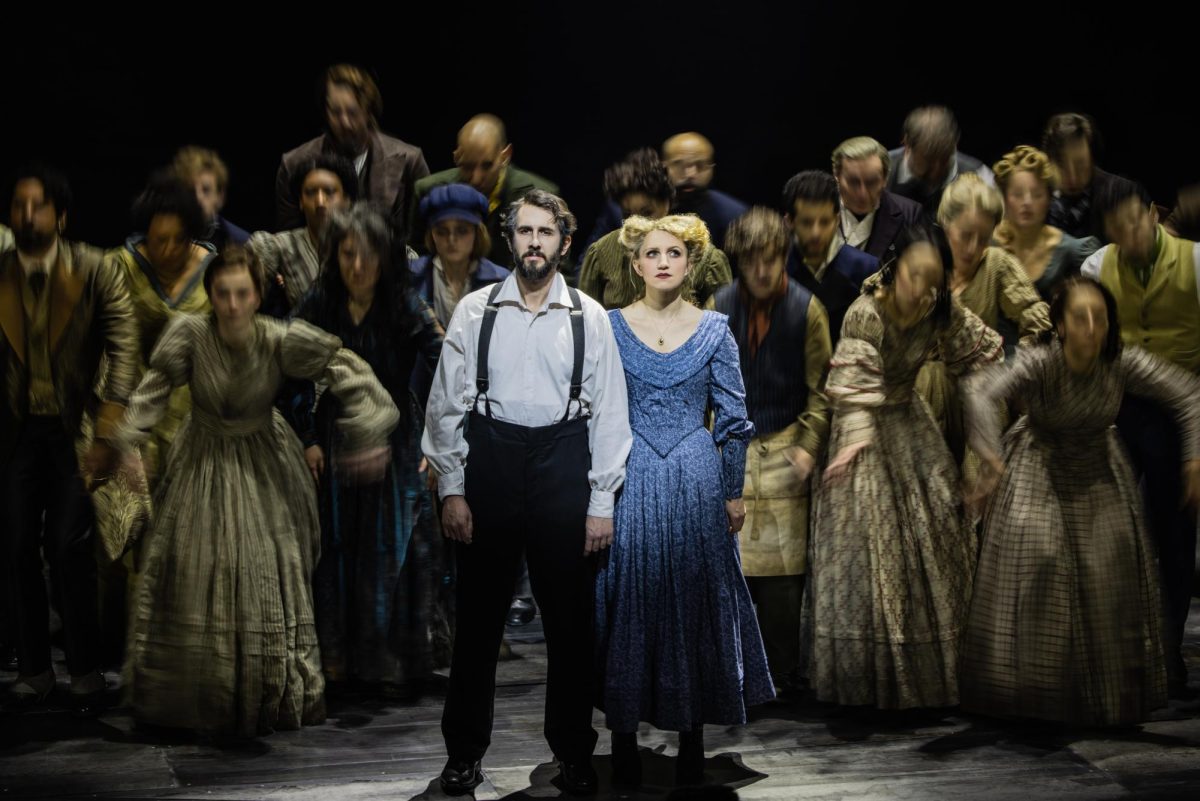When the lights come up at a performance of Broadway’s third revival of “Sweeney Todd” — currently running at the Lunt-Fontanne Theater — audiences are transported to an eerie part of London during the 19th century.
Fog covers the stage and the cast gathers in an enigmatic cluster in the center as they move creepily together to sing the opening number, “The Ballad of Sweeney Todd.” The lyrics urge audience members to “attend the tale” of the titular barber who “shaved the faces of gentlemen who never thereafter were heard of again.”
When Sweeney Todd (Josh Groban) returns to London after being exiled, he seeks revenge on the judge who wronged him and his daughter Johanna (Maria Bilbao). Sweeney plots to murder the judge by offering to shave him before slitting his throat, but he is propelled into madness when his plan fails and pledges retribution on all mankind.
The barber befriends the owner of the struggling pie shop downstairs in the same building, Mrs. Lovett (Annaleigh Ashford), who helps Sweeney disguise his malice by baking his victims into her pies. As a whole, the show examines the dangerous ways revenge can consume a person.
Groban’s scheduled absence from Sept. 11-17 left the lead role to his capable understudies, Nicholas Christopher and Paul-Jordan Jansen.
Christopher brought an impressive lower register and a certain malevolence to the character; his voice suited the character well — differing from Groban’s naturally warmer tone — as heard in the show’s cast recording. When Christopher sang “No Place Like London,” his voice convincingly expressed his disdain for the city that holds so many terrible memories for Sweeney. In his performance of “Epiphany,” where Sweeney turns against all of humanity proclaiming that “they all deserve to die,” Christopher looked into the audience with an intensity and intimacy not often seen in large-scale theater. Leaning almost off the stage, he looked patrons in the orchestra directly in the eye, breaking the fourth wall in an especially intimidating way.
Arguably the strongest aspect of Christopher’s performance was his ability to show a range of contrasting emotions in just a few lines. As the judge sits down for a shave, Sweeney strategically connects with him as they both sing about the “Pretty Women” they admire. Sweeney prepares, knowing this may be his only chance at revenge.
At the end of the song, the judge escapes from Sweeney’s chair, and Christopher effortlessly transitions out of singing the melodic duet and into a fit of fury at the realization that his plan was ruined. His performance was not only impressive but also quite terrifying, fitting for the role of “the demon barber of Fleet Street.”
This contrast exemplifies Sweeney’s mental state and loss of mercy for humanity while still holding so much love for his daughter.
Coming into the show, I was excited to hear Ashford’s rendition of “The Worst Pies in London.” Her performance was everything I’d hoped, humorous in both her intonation and physicality. Later in the show, I was surprised to find that I enjoyed her song “By the Sea” even more, in which Mrs. Lovett expresses her desire to leave the city and make a life with Sweeney. In this number, Ashford outshines herself in characterization and enthusiasm in a masterclass of character acting.
Another standout performance from the show was that of “Stranger Things” star Gaten Matarazzo. With his Broadway roots dating back to “Priscilla, Queen of the Desert” in 2011, he gives an excellent performance as Tobias, a young boy that Mrs. Lovett takes in after Sweeney kills the man for whom he was an apprentice.
Singing the heartfelt “Not While I’m Around” to Mrs. Lovett, Matarazzo’s vocal control and clarity are on full display. He stakes his claim as a star of both screen and stage.
“Sweeney Todd” is not a dance-heavy show, allowing the choreographed moments to enhance the plot throughout. While Mrs. Lovett tells Sweeney of what the judge did to Johanna, their characters dance in silhouettes on the upper portion of the set, re-enacting the story. Their dance combined with Ashford’s sung narration (“Poor Thing”) and Sweeney’s reactions create powerful, emotional imagery of the wrongs that Johanna faced.
Thomas Kail, director of “Sweeney Todd,” created clever moments that juxtaposed between the beautiful music being sung and the gruesome violence concurrently happening on stage. During the ballad “Johanna,” (a true ballad, unlike the opening number) Sweeney sings of the way he dreamed his daughter, whom he hasn’t seen since his exile, might be.
While fantasizing, Sweeney kills several people seemingly effortlessly and without remorse. This contrast exemplifies Sweeney’s mental state and loss of mercy for humanity while still holding so much love for his daughter.
“Sweeney Todd” is complete with Tony Award-winning lighting and sound design, as well as the musical support of one of the largest orchestras currently on Broadway. Though English accents of varying qualities sometimes muddle bits of dialogue, it’s hard not to get pulled into the heinous (though not overly gory) story of the murderous barber’s mission to avenge his family and reunite with his daughter.

